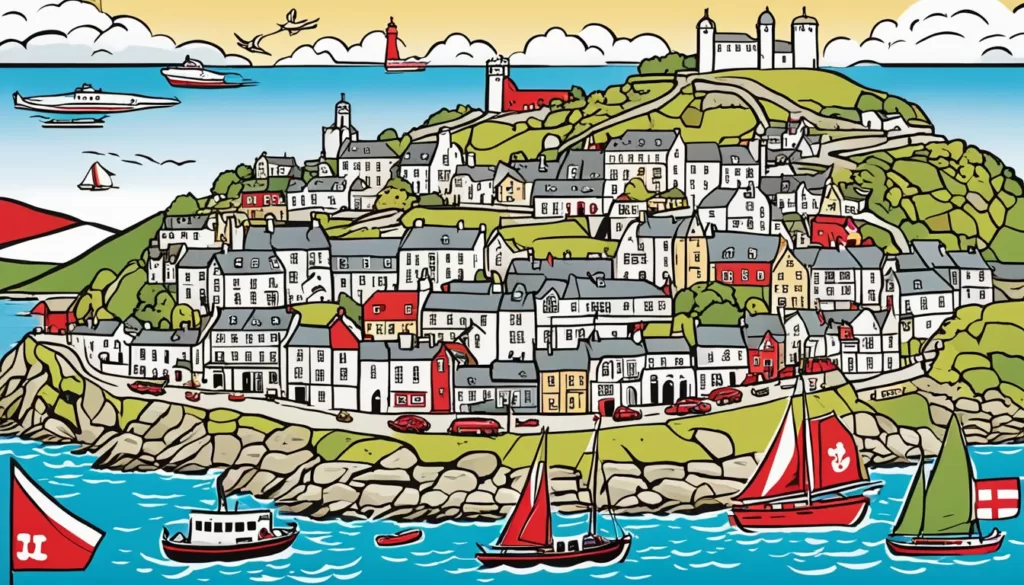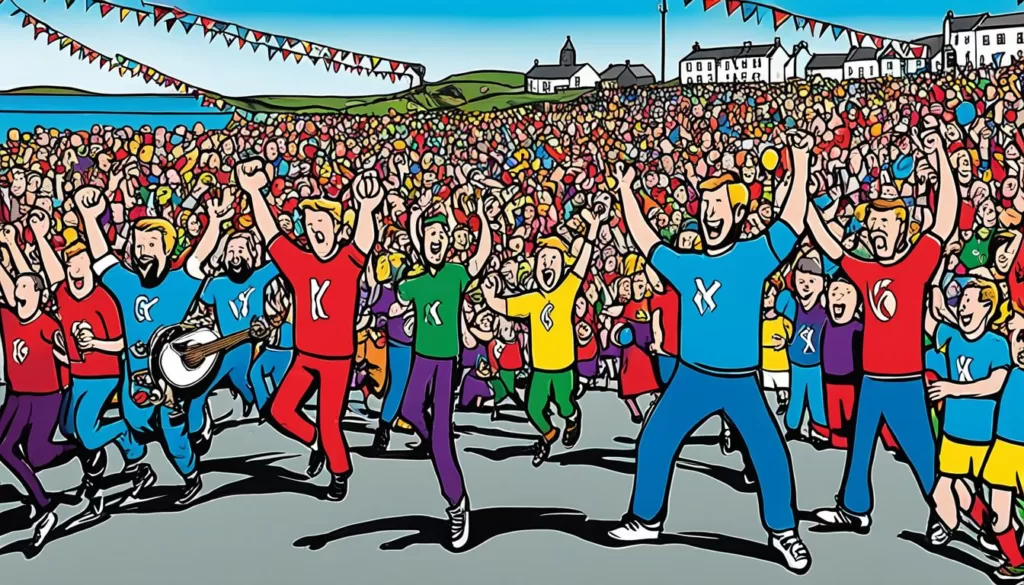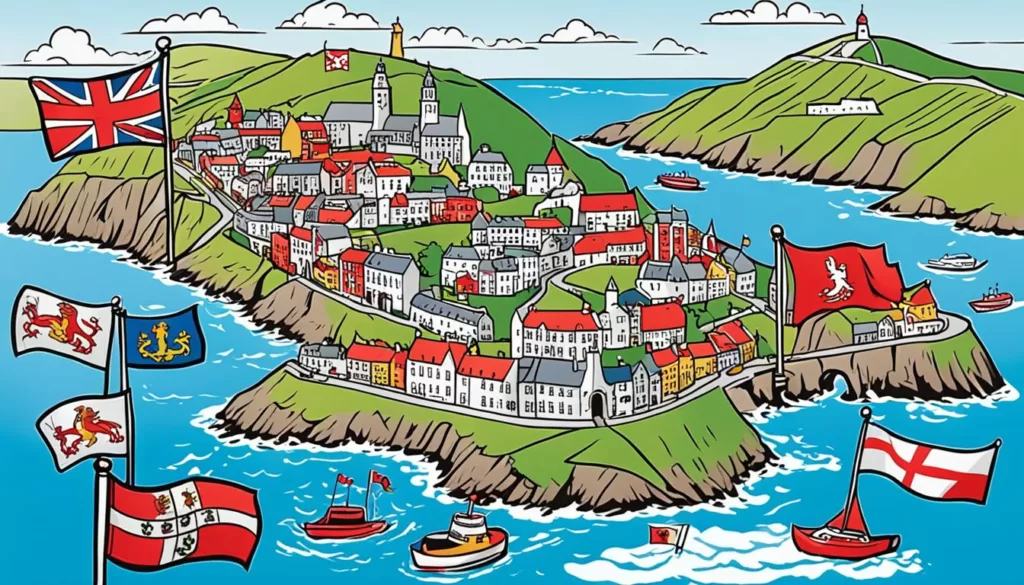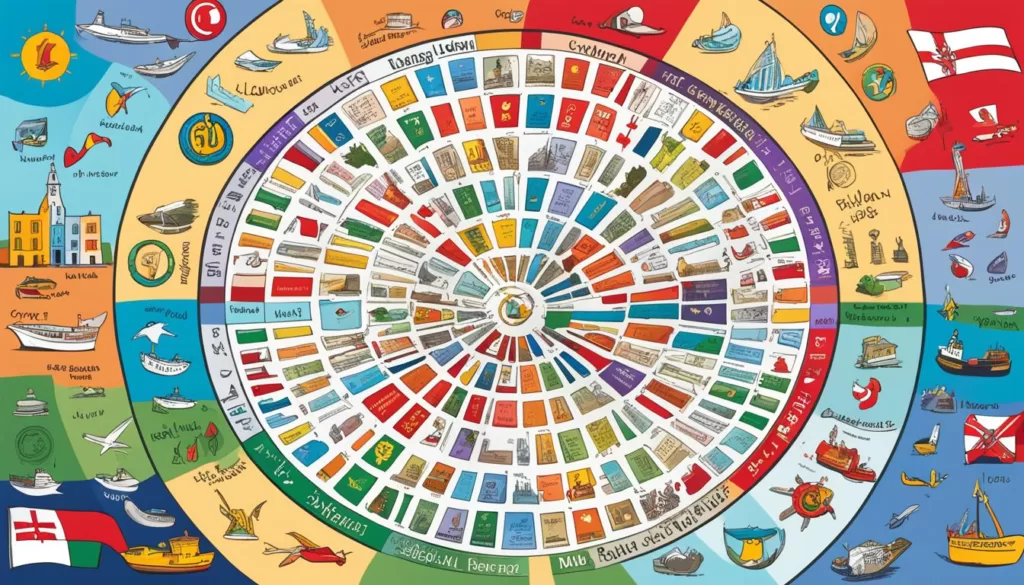The Isle of Man, a breathtaking mosaic of landscapes and lore, is equally diverse in its linguistic offerings. The dominant language spoken here is English, embodying the quintessential flavors of the locale through the distinct Manx English dialect. Language diversity on the Isle of Man extends to the ancient folds of culture with the Manx language – a treasure of Celtic origins known as Manx Gaelic. This language holds a place of honor, marked by its official use in Tynwald, the island’s legislative assembly.
Despite facing endangerment since the passing of Ned Maddrell in 1974, a vibrant spirit persists as educational programs carry the torch forward, enlightening new generations in the Manx language. This illustrates a commitment to cultural integrity and linguistic diversity, ensuring the Isle’s rich linguistic tapestry continues to adorn the community’s identity.
The Isle of Man’s linguistic narrative is an enthralling tale of past and present, a tapestry woven with threads of ancestral Celticism, nourished by continued respect and revitalization. Join us on this journey through the language diversity that enriches the Isle of Man, where the echoes of history meet the voice of today.
Key Takeaways
- English, particularly Manx English, is the predominant language of the Isle of Man.
- Manx Gaelic, a Celtic language with official status, exemplifies the island’s rich heritage.
- The linguistic landscape reflects a commitment to preserving the critically endangered Manx language.
- Language diversity on the Isle of Man is embraced with both historical and pedagogical efforts.
- Manx represents not only a means of communication but also a fundamental facet of the island’s identity.
Exploring the Linguistic Landscape of the Isle of Man
The Isle of Man’s rich linguistic heritage is a vibrant blend of historical and contemporary voices. At the core lies the Manx language, a gem among Celtic languages, woven into the cultural fabric of the island. As we delve into the latticework of languages that contribute to the island’s unique identity, we also recognize the dynamic role of bilingualism and the impact of immigrant languages that add to the diversity of this storied locale.

A Historical Overview of Manx Language Use
The roots of the Manx language delve deep into the history of the Isle of Man, with its branch reaching back to the ancient Celtic tongues of Old Irish. Functioning as one of the official languages Isle of Man takes pride in, Manx showcases a history rich with the lilts and cadences of Goidelic linguistic traditions. While its use as the predominant language waned during the 20th century, a dedicated community has ensured the survival of Manx through translation and education. It is this dedication to language preservation that reflects the bilingualism Isle of Man values so highly.
The Current State of Language Diversity in the Isle of Man
Today’s linguistic scene on the island presents English as the dominant language. However, the diversity of tongues spoken here is expanding through concerted revitalization efforts, particularly in language schools Isle of Man, where Manx is experiencing a renaissance of sorts. A growing number of children and adults alike are learning Manx as a second language, embodying the linguistic diversity Isle of Man is known for. The island’s cultural mosaic strengthens as individuals of all ages connect to their Celtic heritage through the Manx language.
Impact of Immigration on the Isle’s Linguistic Profile
Immigration also shapes the linguistic tapestry of the Isle of Man, introducing a variety of tongues from European and neighboring lands. French, German, and Irish voices mingle within communities, each adding their distinct melodies to the island’s chorus. The immigrant languages Isle of Man is home to have prompted the emergence of new language instruction venues and programs that support and encourage an ever-evolving linguistic landscape. This harmonious interplay of languages not only enriches local communication but also stands as a testament to the inclusive spirit of the island.
For anyone seeking to explore the manifold languages that resonate through the Isle of Man, from the enduring echoes of the Manx to the novel timbres of immigrant languages, the island offers a truly immersive experience. Its educational and cultural initiatives stand as vigilant custodians of a linguistically diverse and welcoming community.
Leveraging Cultural Heritage: The Manx Language
The remarkable surge in Manx Gaelic interest is a testament to the enduring spirit of language preservation on the Isle of Man. With proactive language revitalization efforts Isle of Man has witnessed, the Manx language is experiencing a cultural reawakening. Let’s immerse ourselves in the initiatives and movements that are championing this beloved Celtic tongue.
The Manx Gaelic Revival Movement
Key players in the resurgence of Manx Gaelic include the Manx Language Advisory Council and various cultural organizations, which have banded together to reclaim the language from the brink of extinction. This drive towards a revitalized language presence is a beacon of hope for linguistic diversity.
Drawing from the deep well of tradition, the revival movement places an emphasis on community involvement and education. Language schools Isle of Man have sprung up as crucibles of learning, where the once-dormant lilt of Manx is now being taught to eager learners of all ages.

Educational Initiatives Promoting the Manx Language
Education serves as the cornerstone of the Manx language’s renaissance. Since the 1992 declaration that breathed new life into the language, educational initiatives Manx language have laid the foundation for the next generation of speakers.
New curriculums have woven Manx Gaelic seamlessly into the fabric of academic life. Let’s explore some key educational programs on the island:
| Program | Focus Area | Impact |
|---|---|---|
| Mooinjer Veggey | Preschool language immersion | Fosters early adoption and familiarity with Manx Gaelic |
| Bun-scoill Ghaelgagh | Primary education through Manx | Creates a fluent young cohort of Manx Gaelic speakers |
| Adult language courses | Continued learning and fluency development | Expands the community of adult conversational Manx speakers |
| Culture Vannin | Resources and workshops | Strengthens cultural ties and provides learning materials |
These educational programs are not merely language courses; they are sparks igniting the flame of cultural identity across Isle of Man. It is through these efforts that Manx Gaelic continues to enrapture and enrich the lives of Islanders, ensuring the language’s vitality for years to come.
Languages Spoken Isle of Man: A Focus on Official Tongues
The Isle of Man, revered for its rich cultural tapestry, takes pride in its **official languages**: the widely spoken English language, and the historical Manx language. This linguistic duality plays a pivotal role in the island’s legislative processes within Tynwald, the oldest continuous parliament in the world. Here, laws are meticulously promulgated in both languages, highlighting a balance of heritage and practicality.

Indeed, the Manx language, with roots entwined in the ancient Celtic expanse, possesses an immutable charm that resonates with the echoes of a storied past. Despite facing near extinction, Manx has been bolstered by systematic conservation efforts, underscoring the Isle’s dedication to its linguistic diversity, and securing its place beside English in official capacities. When proceedings are conducted in Tynwald, it’s not just about formality; it’s a declaration of identity, a stance that says both tongues are integral components of Manx society.
The English language, a prominent linguistic force, navigates daily interactions and serves as a bridge connecting the Isle to the expansive world beyond its shores. This prominence is a reflection of English’s utility in international discourse and digital domains, all while supporting the island’s global engagement.
The focus on bilingualism in official contexts does more than honor tradition; it actively cultivates a dialogue between the historical essence of the island and the evolving landscape of contemporary communication. By highlighting both the English language and the Manx language as official tongues, the Isle of Man reaffirms its commitment to cherish and perpetuate its distinct linguistic identity amidst the tempests of change.
The Influence of English and its Variants in the Isle of Man
The colorful spectrum of languages on the Isle of Man is significantly adorned by diverse forms of the English language. With deep-running historical roots and cultural nuances, the variants of English spoken here not only serve as a medium of communication but also exemplify the island’s linguistic evolution and unique identity.
The Prevalence of Manx English
Manx English, a dialect shaped by the Manx language’s lexicon and syntax, serves as a linguistic badge of the island, reflecting its long history and deep-rooted traditions. Once the dominant tongue of famed local writers, this dialect retains unique elements that distinguish it from Standard British English. However, the language landscape on the Isle continues to shift as Manx English now finds itself influenced by other variants of English, particularly those from the northwest of England. This transition mirrors the natural dynamism of language diversity on the Isle of Man.
Forms of Irish English on the Isle
Another facet of the island’s rhetoric is the variations of Irish English, which have trickled into the Manx colloquial stream from Dublin and Belfast. Endorsed by the shared histories and connections between the isles, Irish English has left a notable imprint on the linguistic diversity of the Isle of Man. Echoing through the interactions of the local populace, Irish tourists, and settlers, these forms add richness to the island’s varying cadences of the English language.

The Presence of Minority and Immigrant Languages
Amidst the Isle of Man’s verdant hills and coastal vistas lies a cultural crossroad, where the voices of minority and immigrant communities contribute to a rich, polyphonic legacy. This intermingling of tongues and traditions reflect the island’s commitment to embracing language diversity Isle of Man as a vibrant part of its societal fabric.

Continental European Languages Among the Isle’s Communities
The linguistic weave of the Isle is enriched by threads of Continental European languages that resonate through the towns and villages. French and German, spoken by expatriates and immigrants, introduce a cosmopolitan flair to the community’s dialogue, bolstering the tapestry of immigrant languages Isle of Man. These languages, along with others brought by new residents, fertilize the cultural soil of the island, allowing residents and visitors to witness the power of linguistic integration.
| Language | Estimated Speakers | Influence on Local Culture | Educational Resources Available |
|---|---|---|---|
| French | Varied, expatriate and learners community | Cultural exchange events, culinary influence | Language classes, bilingual materials |
| German | Minor yet active community | Festivals, music, and artisanal crafts | Community classes, exchange programs |
Understanding British Sign Language Use in the Isle of Man
Implanting inclusivity within its societal paradigm, the Isle of Man embraces the Deaf community by recognizing British Sign Language (BSL) as a critical form of communication. Provisions for sign language interpreters in public services vividly demonstrate the commitment to making all facets of Manx life accessible. This initiative not only affirms the presence of BSL within the cultural mosaic but also fortifies the principle of bilingualism Isle of Man, encapsulating spoken and signed languages alike.
Conclusion
The Isle of Man stands as a bastion of linguistic richness, where the symphony of languages spoken Isle of Man paints a vibrant tableau of cultural legacy. The Isle’s commitment to linguistic preservation and vitality is exemplified by the harmonious coexistence of English and Manx Gaelic as the official languages. Furthermore, the colorful array of immigrant languages and the inclusion of British Sign Language underscore the language diversity Isle of Man cherished by its community.
Through steadfast educational endeavors and robust language revitalization movements, the Isle nurtures its heritage and cements a community where every voice is valued. As the Manx Gaelic tongue experiences an awakening, it renews bonds with the past while creating bridges to the future. This linguistic renaissance not only enriches local culture but also elevates it as a cornerstone of the island’s identity.
In conclusion, the Isle of Man exemplifies how a community can flourish through embracing and promoting its linguistic landscape. From the academic to the everyday, language diversity Isle of Man remains a vibrant thread woven through the fabric of life on the island. It stands as a testament to the enduring power of language as both a conduit for heritage and a herald of inclusion.
FAQ
What languages are spoken on the Isle of Man?
The primary language spoken on the Isle of Man is English, particularly the Manx English dialect. Manx Gaelic, a Celtic language, is also an official language and is experiencing a cultural revival. Additionally, due to immigration, there are small pockets of people who speak other languages, including French and German. British Sign Language is used within the Deaf community.
What is the historical significance of the Manx language?
Manx Gaelic has strong historical roots on the Isle of Man, being descended from Old Irish and related to Scottish and Irish Gaelic. It was widely spoken on the island until the 20th century. Although there were periods when its usage declined significantly, recent efforts have been placed to revive this key part of Manx heritage.
How diverse is the linguistic landscape in the Isle of Man?
While English predominates, there’s a growing language diversity thanks to education and immigration. The Manx language is steadily being revived particularly among the youth, and other languages such as French, German, and Irish are also present due to the island’s changing demographics.
What impact does immigration have on the Isle of Man’s languages?
Immigration has introduced a variety of languages to the Isle of Man, including but not limited to European languages like French and German. This has contributed to the linguistic diversity and led to the presence of language schools catering to these communities.
What is the Manx Gaelic revival movement?
The Manx Gaelic revival movement is an effort to promote and preserve the Manx language, considered critically endangered since the mid-20th century. This includes educational initiatives in schools, cultural events, and support from both government and private organizations to encourage the learning and use of Manx.
Are there educational initiatives on the Isle of Man to promote the Manx language?
Yes, there are several educational initiatives to promote the Manx language, including its incorporation into school curricula and specialized language programs. Children on the Isle of Man have opportunities to learn Manx, and there are resources for adults interested in becoming conversational speakers.
What are the official languages of the Isle of Man?
The official languages of the Isle of Man are English and Manx Gaelic. Both are used in government and legal affairs, particularly during Tynwald proceedings, with a commitment to bilingualism to maintain the island’s cultural heritage.
What is Manx English and how is it distinct?
Manx English is an English dialect unique to the Isle of Man, influenced by the historical Manx language. It has distinctive vocabulary and syntax, but like all languages, it is dynamic and evolving and has absorbed influences from other forms of English, especially from the northwest of England.
Are there forms of Irish English spoken on the Isle of Man?
Yes, variations of Irish English are present on the Isle due to the historical connections with Ireland. This influence is seen in the island’s linguistic tapestry, with Irish tourists and settlers bringing their dialects to the island.
What minority and immigrant languages are spoken in the Isle of Man’s communities?
In addition to the Manx and English languages, there are continental European languages such as French and German spoken within the Isle of Man’s communities, reflecting the rich cultural tapestry of the island’s evolving demographics.
How is British Sign Language used in the Isle of Man?
British Sign Language (BSL) is used by the Isle of Man’s Deaf community as their primary mode of communication. The government facilitates this through the provision of sign language interpreters in various public services, ensuring inclusivity and accessibility for Deaf individuals.






